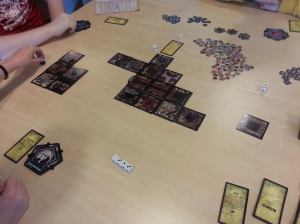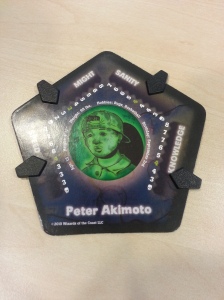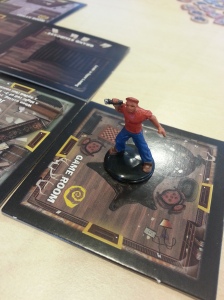Betrayal at House on the Hill is a board game with two phases. In the first phase you and the other players work together to explore the house and find all the things that is hidden inside. In the other phase one of the players will turn into a traitor, he or she might turn into a monster or maybe he or she will create a monster haunting you. Or you might all still be friends and the house turns on you and you have to work together to get out. There are a lot of different things that can happen in the second phase depending on which room he or she is standing in and what omen he or she triggered it with (I will explain this later in this blog).
Items
In the game there are some items that you have to keep an eye on:
Character stat cards
Every player chooses one character they want to play and each character has a character stat card. On this card there are some stats – might, sanity, knowledge and speed. Each category has 8 numbers in descending order ending with a skull, not necessarily from 8-1 rather the same number appears several times in a row. Might and speed are physical stats and sanity and knowledge are mental. If you take physical damage you can choose to split this damage between the two stats and the same with the mental stats. You have one marker for each stat that points on the number you’re currently at, if you take damage this marker moves one step towards the skull in the bottom.
Room cards – At the beginning of the game the room cards are shuffled and laid upside down in a stack next to the beginning rooms (the hallway, the upper landing and the basement landing). They have different symbols on them deciding if and which card you will draw when you enter the room. They have different names and can be put on specific floors, this is shown on the back if it can be put on upper, ground or basement floor or if it can be placed on any of them.
The cards
- Item cards – The items on the item cards can help you or make the situation worse. It can add or remove stats for the player carrying it. Sometimes
- Event cards – In some rooms there is an event happening when you enter it, if you are the first person entering the room you draw an event card telling you what happens. You might fall through the floor down to the basement, taking physical damage, or you might run into a ghost telling you something. Often you need to roll a dice to see if what happens to you is good or bad, if you lose a stat or if you gain one or more.
- Omen cards – Among the omen cards there are some companions you can find, and there are some items and some events. You can be bitten and have roll to see how much damage you take. The companions might give or take away some stats or both. After you draw one of these cards you have to roll a number of dice to see if the next phase – the haunt – will begin or not. If the eyes on the dices are equal to or more than the amount of omen cards drawn the haunt will not begin yet.
A play through
The first phase – the exploring phase
In the exploring phase the players may move as many rooms as their speed shows. If you move through a doorway and there is not already a room there you draw the first room card in the pile that can be placed on the floor you are currently on. Then you place this room with one of its doorways connecting to the doorway you just went through and place your character there. If the room does not tell you to draw a card you can move on exploring new rooms or passing through already explored ones. If it tells you to draw a card you draw the type it says – item, omen or event – and do as it says.
In some rooms there are additional instructions that should be followed either when you leave the room or when the first person ending his or her turn in that room.
If two players are in the same room they can steal items from each other or trade them. When we played the first time one of our players got an omen card saying the batteries in his flashlight were out so he could only take one step each round until he found a candle or was in the same room as another player that could give him some batteries. So this is a game where you help each other but at the same time can backstab your friends by stealing their things and hurting them. This might be bad as they might die really early in the next phase so they can’t help you kill the monster/s if that is what appears in the haunting.
If someone fails the haunt roll (the roll with 6 dice after an omen card has been drawn which I described earlier) the second phase begins.
The second phase – the haunting
The haunt phase starts with the player drawing the omen card checking who the traitor is. This depends on which omen card was drawn when the haunt roll was initiated and in which room the player is standing in while drawing the card. The player that becomes the traitor gets a special manual with all the possible scenarios. Which haunt is going to happen is decided exactly like who is the traitor. The traitor then leaves the room and reads in on the haunt, what will happen and how. Meantime the heroes (the other players) read in another manual what will happen on their part, what they have to do to win.
When all know what is happening and what they have to do the traitor return to the others and prepares the haunt. In the two times we played the traitor ones became a snake with two heads and the other time she created Frankenstein’s monster. To win the heroes had to kill the two heads of the snake or to kill Frankenstein’s monster. For the traitor to win she had to kill all of the heroes or with the snakes heads have been in sixteen rooms. So this game has a lot of different and interesting endings
Core game system
We discussed this in the group and found it extremely hard to decide which the core system throughout the game was since it has two phases. But we decided that it was exploring new rooms in the house. Since you can do this in both phases and it is what basically triggers the haunting phase.
The best
The best things in this game are the storytelling, the multiple endings, the dice and the randomness. The dice have 0, 1 and 2 eyes on its sides which make it possible to take no damage at all since the damage is based on dice roll. The storytelling, randomness and multiple endings makes it fun to play this game over and over again since it’s so different every time, you will probably never get the exact same gameplay twice. With the randomness I mean during the exploring phase – the rooms appear in different order and places, and the cards are drawn randomly.
The worst
The worst part of this game was the characters being so unbalanced, one of the characters was just dominating both of our gameplays. And the stats between the characters are not balanced, some hade very low numbers on their stat cards and others (specially one) had very high numbers. These numbers decide how many dice you get to roll in each skill check which makes it very much easier for some of the players to make these.
Both good and bad
In the exploring phase you mostly explore new rooms and most of the rooms makes you draw a card and can’t take any more steps. This is both good and bad since it makes you feel very slow, but you won’t get an advantage if you start.
Most interesting system
The most interesting system in this game is the haunt since it varies the so much. There are about 40 different haunts and in some of them the traitor isn’t a traitor but still a hero and the house is against the heroes. It’s just so many different scenarios and it makes the game interesting every time you play it.
Target audience
The target audience for Betrayal at House on the Hill was over 12 years. We agree that the players should not be under 12 years since they probably don’t have as much patience and understanding as someone over 12. But we do think that the age should maybe be a bit higher than 12 since if the one who becomes the traitor is 12 years it might be hard for him or her when all the other players are against him or her, and it might be hard to keep track of everything alone for such a young person. This could be fixed by a parent or older friend or someone like that chooses to help so there are two traitors instead of one.
Summary
So this game is all about the story and exploring. It is fun because there are so many different endings and gameplays and it’s probably enjoyed by everyone who likes storytelling and probably role-players as well.



October 2nd, 2014 at 5:14 pm
I agree with the exploration and character’s movement being the core system of this game, as it is important both before the Haunt phase starts but also after the Haunt has started. By exploring the house and finding its new rooms, the game’s board is created. While exploring you also trigger different events as well as finding items and omens. The exploration does not only cause the haunt phase to begin, but sometimes you have to find certain rooms or items in order to win depending on what haunt tale was triggered, and this can only be achieved by exploring. As you do not know which room cards you pick, the house’s layout is always different and so every game session is like exploring a new house. The different traits of the rooms can also result in some players dying/losing the game, as there are some rooms that lowers the number of dice you can throw and some rooms can make you lose trait points.
You picked many things to be the best parts of this game, and I agree with you on all of them. I would however only pick one best part of the game, which is what all those best things result in; replayability.
The fifty different haunt tales seem to be very different from each other, they can differ in stories, winning conditions, traitors and monsters. The different haunt scenarios change the game play completely. Sometimes you play as the only traitor, sometimes there are several traitors, sometimes all players are heroes and there is even scenarios with hidden traitors. The winning conditions of the traitor and the heroes in the scenario you are playing also affect how important exploration is.
Even if you have played all fifty haunt scenarios, you can still have very different game sessions, as the exploration also causes the game to be different every time you play. The game board is never the same, as you do not know which room card will be picked and also because the item, event and omen cards are also shuffled, the rooms do not always trigger the same events to happen. There are also rooms with dead ends, and the rooms with special traits that can affect your traits’ stats and how many dice you throw whilst in that room.
Same thing with the dice, even if some players had many dice to throw, they could have very bad luck and get the blank sides on most dice. This is also good because it makes the unbalanced trait stats of the characters a little less obvious at some times. With the dice’s having blank sides of them, it did not always mean that you had to lose health/trait points when attacked.
My group did not have time to play the game as much as we wanted to, so I did not have much time to experience the unbalance between the character’s different traits stats. I can however imagine many scenarios in which the unbalanced traits can ruin the game. If a player has high numbers on her traits’ stats, she has more dice to throw. The more dice you throw, the easier it is for this player to throw higher numbers, which often is required for getting the good sides of event, omen, room or item cards. Therefore, having it easier to throw higher numbers also makes it easier for the player to get higher traits. It is the opposite for the players with low traits’ stats. She often has less dice to throw, which makes it harder to throw high numbers which might often result in bad throws and her getting the bad sides of the cards and so her traits get even lower. It is kind of like Monopoly; the leading player is the most rewarded player and is pretty much guaranteed to win, whilst the player with low trait stats is getting worse and worse stats till she loses.
You say that the “drawing of cards” in newly discovered rooms is a both good and bad thing, but I would disagree with it being bad. Sure, it might make you feel slow because you had maybe five points in your speed taint and you only got to use one, but when you are not exploring new rooms but maybe escaping a monster and running through already discovered rooms you do not feel as slow. This makes the unbalanced characters a little less unbalanced, as the players with a high speed trait can’t discover 6+ rooms on her turn. This would also result in this player having many items and so she would be even more overpowered. If the players were not stopped by events in rooms, the haunt session would start even earlier during the game too, since many omen cards would be picked. Furthermore, the other players would have to wait a longer time if other players were allowed to trigger many events, and you would also quickly run out of room cards and so there would be no exploration left later in the game.
As I stated earlier, the different haunt scenarios result in a high replayability, and so I agree with it being the most interesting system as well. The players are all explorers until the haunt starts, which make the players more careful with each other, as anyone could become the traitor at any time. That is why you do not focus on lowering someone else’s stats before the haunt starts, but instead you mostly focus on improving your own character’s stats and item supply during the exploration phase. The players do not know what haunt will be triggered and they do not know when either.
I too agree on the game’s own chosen target audience. Not only would it be difficult for someone younger than 12 to keep track of everything to do as an alone traitor, but there are also some haunt stories that could be very disturbing for them. Even I was a little disturbed by the haunt scenario that my group played; where the traitor found his or her friends to be the perfect fertilizer for his/her vines and therefore set out to kill them, and this is probably not even the close to being the most disturbing haunt story of the game. Therefore I think from 12 and up is a good age suggestion.
Good job with the blog post and the analyzing of the game! Take care!
Nicolina